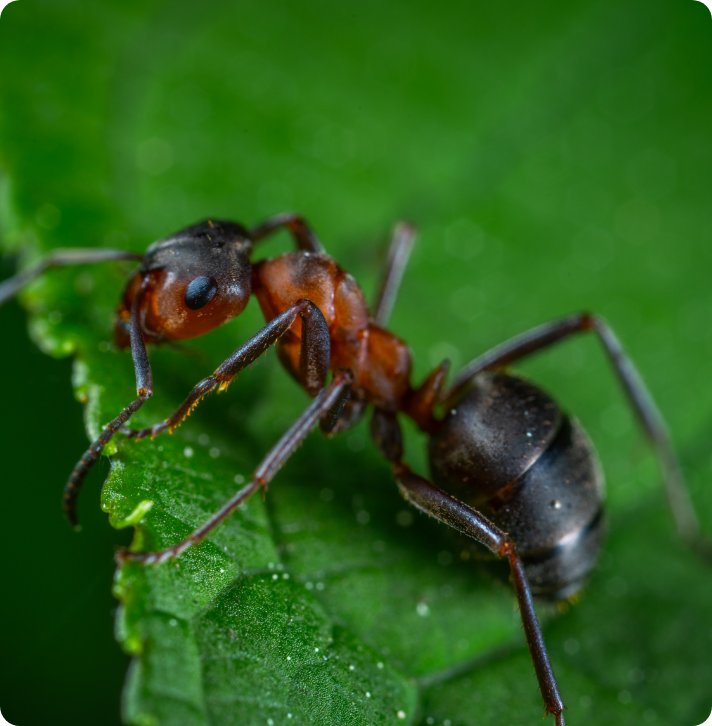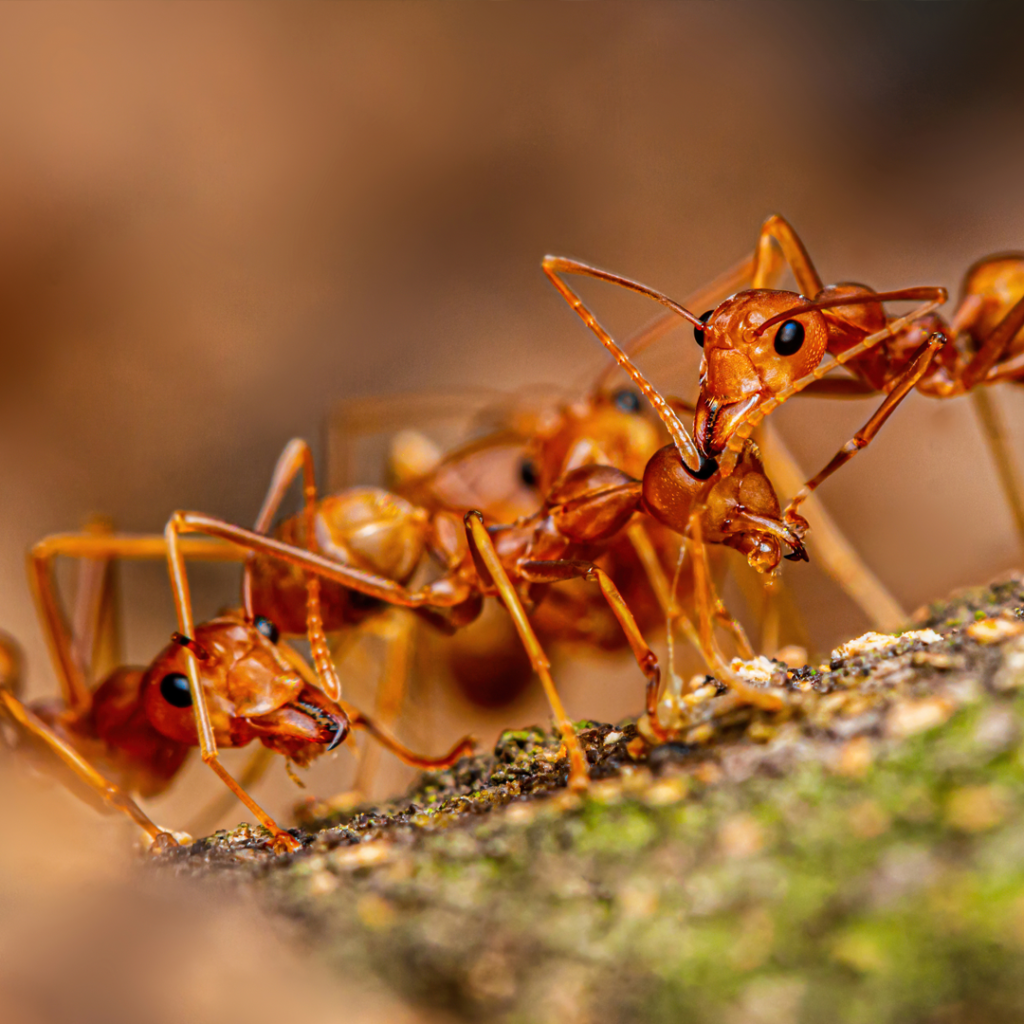


Seeing one or two ants in your home can feel like a minor annoyance, but it’s important to deal with it quickly. If left untreated, ants can cause significant damage to walls, windows, door frames, porches, and other wood areas in your home. Certain types of ants can also bite and sting, posing a potentially severe health risk to you and your family.
Ant infestations can spread quickly, but our Coachella Valley ant control experts can help. Contact us today and let us treat ant infestations for good.
What kind of ant is in your home? Here’s how to identify the most common ants found in the Coachella Valley area:
Argentine Ant Identification:
Argentine ants are dark brown or black and about 1/8 – 3/16 of an inch long. They have straight 12-segmented antennae.
Carpenter Ant Identification:
Carpenter ants are winged ants about half an inch long or more. They’re black in color, with bent antennae and a narrow waist. Signs of a carpenter ant infestation are a small opening in wood with a tiny pile of sawdust beneath, or hearing a slight rustling inside your walls.
Pavement Ant Identification:
Pavement ants are about 1/8 of inch long, dark red in color, and winged.
Thief Ant Identification:
Thief ants are about 1/16 of an inch long, and are a brownish-yellow color. They have 10-segmented antennae that end with a two-segmented club. Thief ants are attracted to greasy food, meat, and cheese.
The habitat of the ant varies from species to species, so it’s important to identify the type of ant you may be dealing with in your home.
An ant colony’s queen lays eggs which hatch within 1-2 weeks. Then, they enter the larvae phase which lasts 6-12 days. In this phase, the ant larvae are wormlike, lacking eyes and legs. They rely on other ants to feed them. After several molting stages, the larvae turn into pupae, with legs and antennae folded against their bodies. Ants begin the pupal stage nearly white. Some ants live in cocoons during this stage, while others do not. This stage lasts from 9-30 days.
Fertilized ant eggs become female workers that go out in search of food, feed other ants, and sometimes become queens themselves. Unfertilized ant eggs become male drones and mates for the queen. The life of an individual ant depends on its role in the colony. Male drones live for a few weeks, but a queen can live for up to 30 years. For this reason, ant colonies can persist and grow for many years if left untreated – and can contain thousands to millions of ants.
Rudy’s Termite & Pest Control is your Coachella Valley expert in identifying and treating ant infestations. Let us help you today!
Most species of ant live outdoors and enter homes in search of food. To help prevent ant infestations in your home, wipe up crumbs and pack food away in sealed containers. Seal cracks in walls and floors and around windows, and keep plants and bushes well away from windows and exterior walls. Avoid overwatering your lawn and using strong chemical products to fight ant infestations, as they can make conditions worse.
You might have an ant infestation if you see ants moving in a line along your floor or walls, ants living in mounds of dirt near your home, or small openings in wood with tiny piles of sawdust beneath.
Most species of ant do not directly harm people or carry disease, but their appearance in your kitchen and even in your food can indirectly pose a health risk.
Quelling an ant infestation as soon as possible is important. Ant colonies can be very large, with workers invading your home and even your food. Through pheromones, ants leave signals to other members of their colony that act as a roadmap through your home to food and water sources.
Certain types of ants such as carpenter ants can also cause structural damage to your home that you may not be able to see at a glance.
Dealing with an ant infestation in your home depends on the species of ant present. It’s important to rely on experts to accurately assess the ant problem and carry out the most effective solution. Rudy’s Termite & Pest Control is your Coachella Valley expert in effectively dealing with ant infestations in your home or business. Let us help you today!

Seeing one or two ants in your home can feel like a minor annoyance, but it’s important to deal with it quickly. If left untreated, ants can cause significant damage to walls, windows, door frames, porches, and other wood areas in your home. Certain types of ants can also bite and sting, posing a potentially severe health risk to you and your family.
Ant infestations can spread quickly, but our Coachella Valley ant control experts can help. Contact us today and let us treat ant infestations for good.
What kind of ant is in your home? Here’s how to identify the most common ants found in the Coachella Valley area:
Argentine Ant Identification:
Argentine ants are dark brown or black and about 1/8 – 3/16 of an inch long. They have straight 12-segmented antennae.
Carpenter Ant Identification:
Carpenter ants are winged ants about half an inch long or more. They’re black in color, with bent antennae and a narrow waist. Signs of a carpenter ant infestation are a small opening in wood with a tiny pile of sawdust beneath, or hearing a slight rustling inside your walls.
Pavement Ant Identification:
Pavement ants are about 1/8 of inch long, dark red in color, and winged.
Thief Ant Identification:
Thief ants are about 1/16 of an inch long, and are a brownish-yellow color. They have 10-segmented antennae that end with a two-segmented club. Thief ants are attracted to greasy food, meat, and cheese.
The habitat of the ant varies from species to species, so it’s important to identify the type of ant you may be dealing with in your home.
An ant colony’s queen lays eggs which hatch within 1-2 weeks. Then, they enter the larvae phase which lasts 6-12 days. In this phase, the ant larvae are wormlike, lacking eyes and legs. They rely on other ants to feed them. After several molting stages, the larvae turn into pupae, with legs and antennae folded against their bodies. Ants begin the pupal stage nearly white. Some ants live in cocoons during this stage, while others do not. This stage lasts from 9-30 days.
Fertilized ant eggs become female workers that go out in search of food, feed other ants, and sometimes become queens themselves. Unfertilized ant eggs become male drones and mates for the queen. The life of an individual ant depends on its role in the colony. Male drones live for a few weeks, but a queen can live for up to 30 years. For this reason, ant colonies can persist and grow for many years if left untreated – and can contain thousands to millions of ants.
Rudy’s Termite & Pest Control is your Coachella Valley expert in identifying and treating ant infestations. Let us help you today!
Most species of ant live outdoors and enter homes in search of food. To help prevent ant infestations in your home, wipe up crumbs and pack food away in sealed containers. Seal cracks in walls and floors and around windows, and keep plants and bushes well away from windows and exterior walls. Avoid overwatering your lawn and using strong chemical products to fight ant infestations, as they can make conditions worse.
You might have an ant infestation if you see ants moving in a line along your floor or walls, ants living in mounds of dirt near your home, or small openings in wood with tiny piles of sawdust beneath.
Most species of ant do not directly harm people or carry disease, but their appearance in your kitchen and even in your food can indirectly pose a health risk.
Quelling an ant infestation as soon as possible is important. Ant colonies can be very large, with workers invading your home and even your food. Through pheromones, ants leave signals to other members of their colony that act as a roadmap through your home to food and water sources.
Certain types of ants such as carpenter ants can also cause structural damage to your home that you may not be able to see at a glance.
Dealing with an ant infestation in your home depends on the species of ant present. It’s important to rely on experts to accurately assess the ant problem and carry out the most effective solution. Rudy’s Termite & Pest Control is your Coachella Valley expert in effectively dealing with ant infestations in your home or business. Let us help you today!
"*" indicates required fields